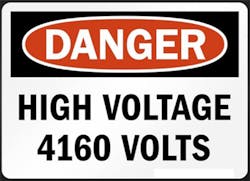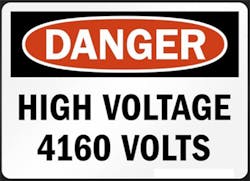Voltage Levels and the National Electrical Code
Ask control systems engineers what the term “high voltage” means to them, and you’re liable to get an answer such as “anything over 50V”. Ask a utility lineman the same question, and you may hear “anything over 69kV”. So, the terminology — low, medium, and high voltage — are relative to the field you are in and which context is being used.
The National Electrical Code (NEC) uses all three terms, but doesn’t directly define them. However, in Art. 100, Informational Note 2 refers to NEMA C84.1, American National Standard for Electric Power Systems and Equipment–Voltage Ratings (60 Hertz). In C84.1-2016, Section 3, system voltage classes are defined as follows:
“3.1 Low Voltage (LV): A class of nominal system voltages 1,000V or less.
3.2 Medium Voltage (MV): A class of nominal system voltages greater than 1,000V and less than 100kV.
3.3 High Voltage (HV): A class of nominal system voltages equal to or greater than 100kV and equal to or less than 230kV.
3.4 Extra-High Voltage (EHV): A class of nominal system voltages greater than 230kV but less than 1,000kV.
3.5 Ultra-High Voltage (UHV): A class of nominal system voltages equal to or greater than 1,000kV.”
There is no correlation between the NEMA system voltage classes and the NEC. For instance, most chapters are broken up by voltages equal to or less than 1,000V and those that are greater than 1,000V. For clarity, it’s always best to mention the nominal voltage being discussed, such as, 5kV, 15kV, etc., instead of using vague terms such as medium voltage.
About the Author
Eddie Guidry
Senior Fellow
Eddie Guidry is a senior fellow with Fluor Enterprises, Inc., Sugar Land, Texas. He is highly skilled in electrical and control systems for industrial construction, design, and engineering (both domestic and abroad). The majority of Eddie’s 38 years of experience includes upstream and downstream portions of petrochemical plants and refineries. He is also heavily experienced in water and wastewater treatment facilities. Eddie is very active in the development of U.S. national (ANSI) and international codes and standards, and has been a principal member of the National Fire Protection Association (NFPA) National Electrical Code (NEC) committee since 1999 and NFPA’s National Advisory Committee on Electrical Safety Research since 2008. Eddie, who has also developed and conducted many electrical courses and seminars over the years, currently holds the corporate Master Electrician license for Fluor Corporation in the State of Texas and is also an ICC/IAEI certified electrical inspector.

